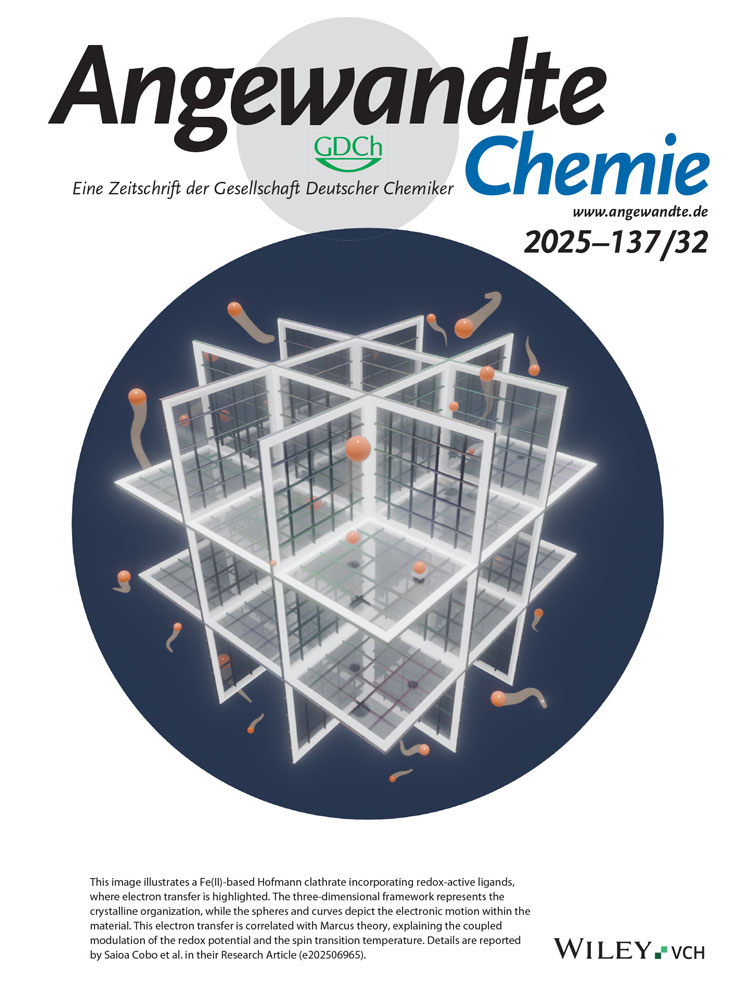Propargylierung von Carbonylverbindungen durch Umpolung von Propargylpalladiumkomplexen mit Diethylzink
Corresponding Author
Prof. Yoshinao Tamaru
Department of Applied Chemistry, Faculty of Engineering Nagasaki University, 1–14 Bunnkyo, Nagasaki 852 (Japan) Telefax: Int. + 958/47–9008
Department of Applied Chemistry, Faculty of Engineering Nagasaki University, 1–14 Bunnkyo, Nagasaki 852 (Japan) Telefax: Int. + 958/47–9008Search for more papers by this authorSachio Goto
Department of Applied Chemistry, Faculty of Engineering Nagasaki University, 1–14 Bunnkyo, Nagasaki 852 (Japan) Telefax: Int. + 958/47–9008
Search for more papers by this authorAkihiro Tanaka
Department of Applied Chemistry, Faculty of Engineering Nagasaki University, 1–14 Bunnkyo, Nagasaki 852 (Japan) Telefax: Int. + 958/47–9008
Search for more papers by this authorMasamichi Shimizu
Department of Applied Chemistry, Faculty of Engineering Nagasaki University, 1–14 Bunnkyo, Nagasaki 852 (Japan) Telefax: Int. + 958/47–9008
Search for more papers by this authorDr. Masanari Kimura
Department of Applied Chemistry, Faculty of Engineering Nagasaki University, 1–14 Bunnkyo, Nagasaki 852 (Japan) Telefax: Int. + 958/47–9008
Search for more papers by this authorCorresponding Author
Prof. Yoshinao Tamaru
Department of Applied Chemistry, Faculty of Engineering Nagasaki University, 1–14 Bunnkyo, Nagasaki 852 (Japan) Telefax: Int. + 958/47–9008
Department of Applied Chemistry, Faculty of Engineering Nagasaki University, 1–14 Bunnkyo, Nagasaki 852 (Japan) Telefax: Int. + 958/47–9008Search for more papers by this authorSachio Goto
Department of Applied Chemistry, Faculty of Engineering Nagasaki University, 1–14 Bunnkyo, Nagasaki 852 (Japan) Telefax: Int. + 958/47–9008
Search for more papers by this authorAkihiro Tanaka
Department of Applied Chemistry, Faculty of Engineering Nagasaki University, 1–14 Bunnkyo, Nagasaki 852 (Japan) Telefax: Int. + 958/47–9008
Search for more papers by this authorMasamichi Shimizu
Department of Applied Chemistry, Faculty of Engineering Nagasaki University, 1–14 Bunnkyo, Nagasaki 852 (Japan) Telefax: Int. + 958/47–9008
Search for more papers by this authorDr. Masanari Kimura
Department of Applied Chemistry, Faculty of Engineering Nagasaki University, 1–14 Bunnkyo, Nagasaki 852 (Japan) Telefax: Int. + 958/47–9008
Search for more papers by this authorAbstract
References
- 1
S. A. Godleski
in
Comprehensive Organic Synthesis,
Vol. 4
(Hrsg.: B. M. Trost,
I. Fleming,
M. F. Semmelhack),
Pergamon, Oxford,
1991,
S. 585–661;
10.1016/B978-0-08-052349-1.00105-0 Google ScholarR. F. Heck, Palladium Reagents in Organic Synthesis, Academic Press, London, 1985.
- 2
Umpolung durch Transmetallierung mit Diethylzink: a)
Y. Tamaru,
A. Tanaka,
K. Yasui,
S. Goto,
S. Tanaka,
Angew. Chem.
1995,
107,
862–864;
10.1002/ange.19951070710 Google ScholarAngew. Chem. Int. Ed. Engl. 1995, 34, 787–789; b) K. Yasui, Y. Goto, T. Yajima, Y. Taniseki, K. Fugami, A. Tanaka, Y. Tamaru, Tetrahedron Lett. 1993, 34, 7619–7622; c) Umpolung durch Reduktion mit einem Metall: Y. Masuyama, Y. Nimura, Y. Kurusu, Tetrahedron Lett. 1991, 32, 225–228; Y. Masuyama, J. P. Takahara, Y. Kurusu, J. Am. Chem. Soc. 1988, 110, 4473–4474; d) Umpolung durch elektrochemische Reduktion: P. Zhang, W. Zhang, T. Zhang, Z. Wang, W. Zhou, J. Chem. Soc. Chem. Commun. 1991, 491–492; S. Torii, H. Tanaka, T. Katoh, K. Morisaki, Tetrahedron Lett. 1984, 25, 3207–3208; e) Umpolung durch den Einbau von Heteroatomen: J. P. Takahara, Y. Masuyama, Y. Kurusu, J. Am. Chem. Soc. 1992, 114, 2577–2586; S. Matsubara, K. Wakamatsu, Y. Morizawa, N. Tsuboniwa, K. Oshima, H. Nozaki, Bull. Chem. Soc. Jpn. 1985, 58, 1196–1199.
- 3 E. Keinan, E. Bosch, J. Org. Chem. 1986, 51, 4006–4016; C. J. Elsevier, P. M. Stehouwer, H. Westmijze, P. Vermeer, J. Org. Chem. 1983, 48, 1103–1105; K. Ruitenberg, H. Kleijn, C. J. Elsevier, J. Meijer, P. Vermeer, Tetrahedron Lett. 1981, 22, 1451–1452; T. Jeffery-Luong, G. Linstrumelle, Tetrahedron Lett. 1980, 21, 5019–5020.
- 4 C.-C. Su, J.-T. Chen, G.-H. Lee, Y. Wang, J. Am. Chem. Soc. 1994, 116, 4999–5000; J. Tsuji, H. Watanabe, I. Minami, I. Shimizu, J. Am. Chem. Soc. 1985, 107, 2196–2198.
- 5 Alle in Tabelle 1 aufgeführten Produkte wurden durch spektroskopische Methoden (IR, 400-MHz-1H-NMR, hochauflösendes MS) und Elementaranalysen charakterisiert.
- 6 Ketone scheinen ähnlich gut zu reagieren. So ergab die Reaktion von 1 b (X = OBz) mit Acetophenon unter den in Eintrag 2 von Tabelle 1 genannten Bedingungen (THF, 29 h) 3-Methyl-2-phenyl-4-pentin-2-ol in 58% Ausbeute.
- 7 Die Komplexe III und IV mit M = ZnEt, ZnEt2− könnten über einen ähnlichen Übergangszustand gebildet worden sein, wie er für die Wanderung einer Allylgruppe von π-Allylpalladium zu Zn2 + angenommen wird [2 a].
- 8
E. J. Corey,
K. A. Cimprich,
J. Am. Chem. Soc.
1994,
116,
3151–3152;
J. A. Marshall,
J. Perkins,
J. Org. Chem.
1994,
59,
3509–3511;
H. Yamamoto in
Comprehensive Organic Synthesis,
Vol. 2
(Hrsg.: B. M. Trost,
I. Fleming,
C. H. Heathcock),
Pergamon, Oxford,
1991,
S. 81–98.
10.1016/B978-0-08-052349-1.00025-1 Google Scholar
- 9 III mit M = ZnCl ergibt anti-2 mit hoher Selektivität: G. Zweifel, G. Hahn, J. Org. Chem. 1984, 49, 4565–4567.
Citing Literature
This is the
German version
of Angewandte Chemie.
Note for articles published since 1962:
Do not cite this version alone.
Take me to the International Edition version with citable page numbers, DOI, and citation export.
We apologize for the inconvenience.





